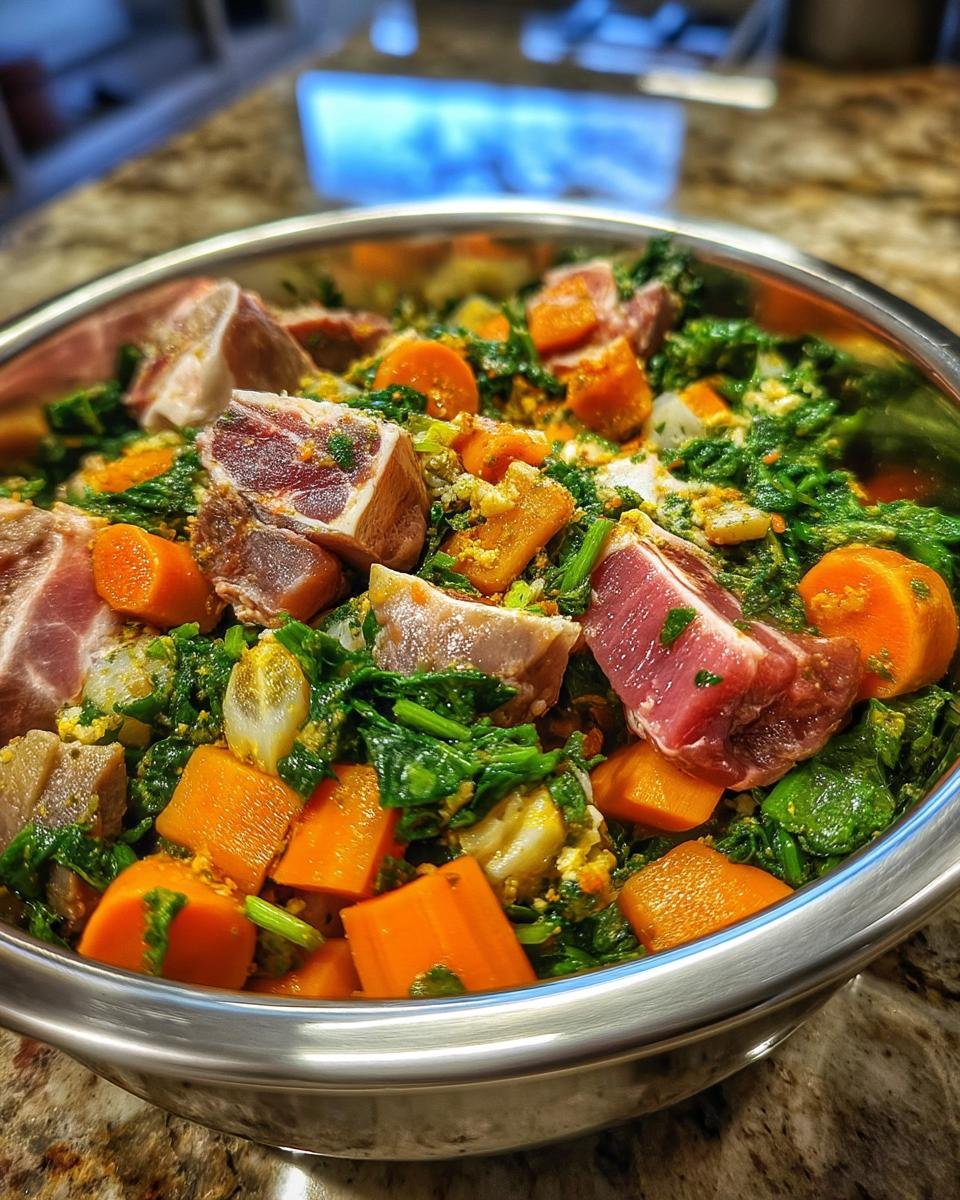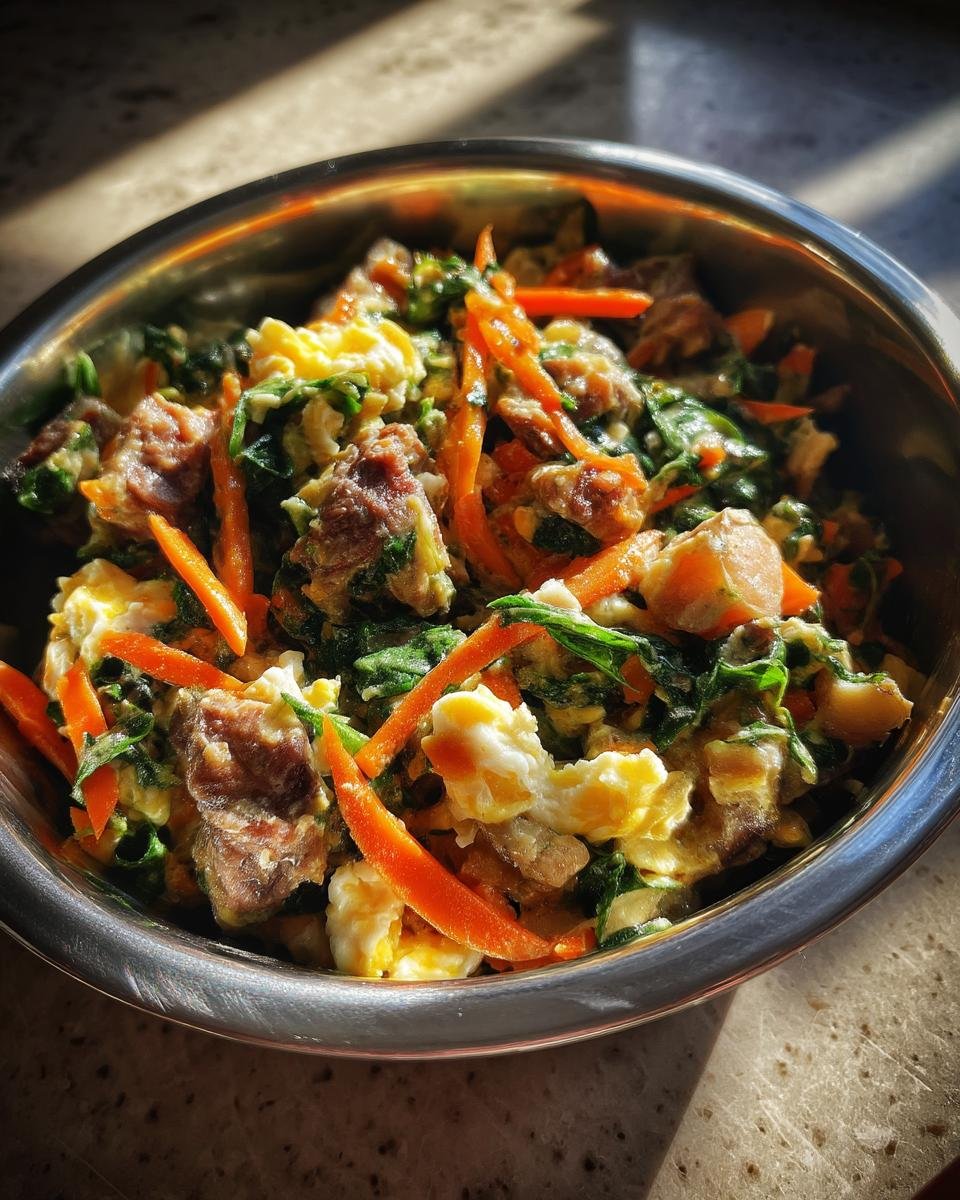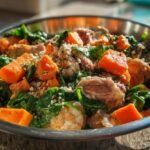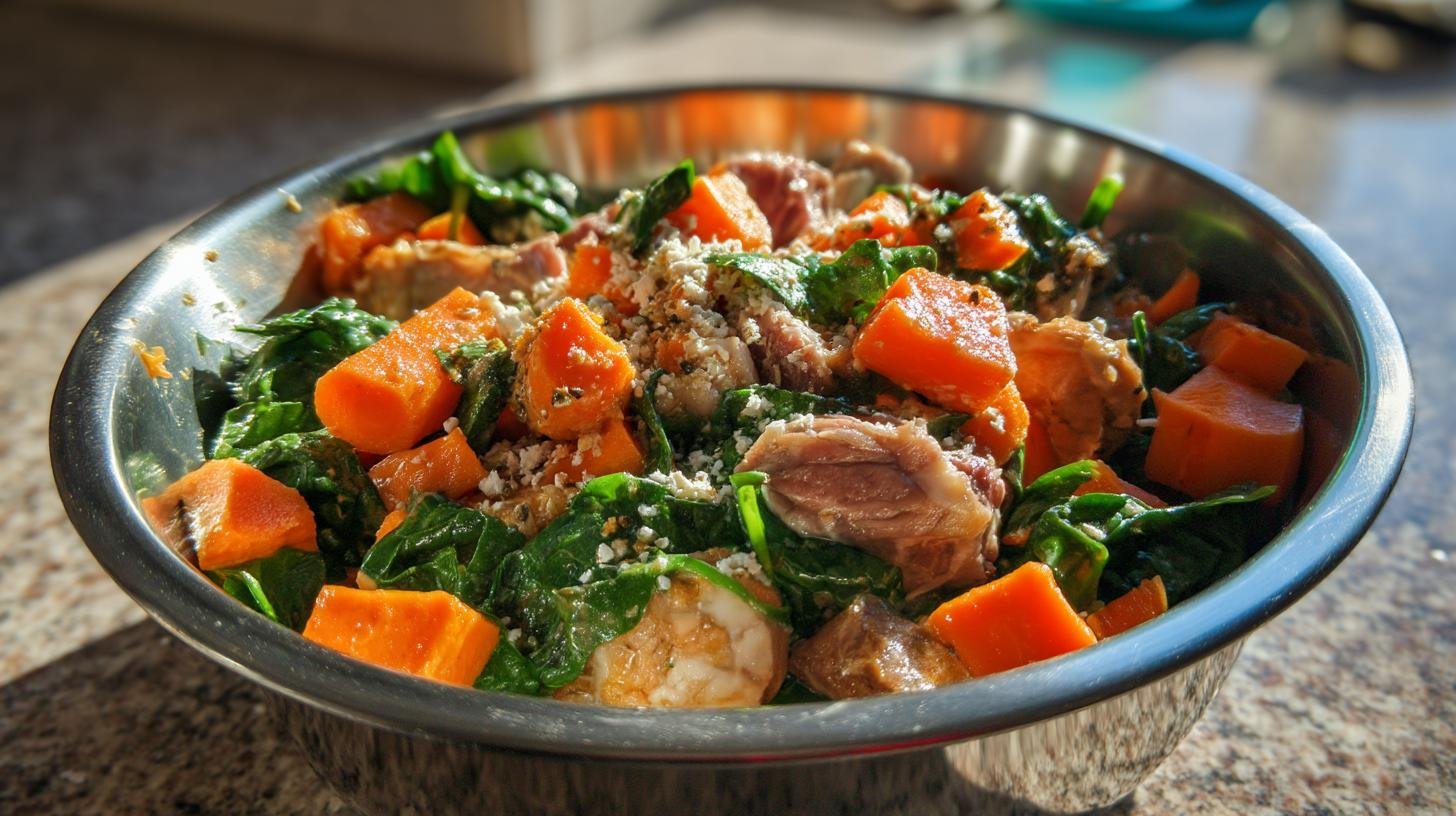When my Great Dane, Moose, started struggling with his energy and joints around age three, I knew his kibble diet wasn’t cutting it anymore. That’s when I dove head-first into raw feeding for large breeds—and wow, what a difference it made. Within weeks, his coat gleamed, his muscles filled out, and he had this new bounce in his step I hadn’t seen since he was a pup!
Large breed dogs have big needs—literally. They burn through calories faster, carry more weight on their joints, and need serious protein for muscle support. This raw recipe checks all those boxes. It’s packed with fresh meat, bone-in cuts for calcium, and just enough veggies for fiber and antioxidants. Plus, it’s totally doable in your own kitchen—no fancy tools or mystery ingredients. I’ve been making this for years now, and every time I portion it out, Moose is already drooling by my feet. If you’re ready to see your big dog thrive, let’s get into it!

Ingredients for Raw Feeding for Large Breeds
500 grams of bone-in chicken thighs, chopped into bite-sized chunks. 300 grams of beef chunks, ideally lean and trimmed. 200 grams of raw organ meat—use a mix of liver and kidney for balanced nutrients. 150 grams of chopped carrots for fiber and crunch. 100 grams of fresh spinach, finely shredded. 2 tablespoons of fish oil, preferably wild-caught salmon oil, to support coat and joint health. 1 whole raw egg, including the crushed shell for natural calcium. 1 teaspoon of calcium supplement powder, especially important for strong bones in large breeds.
This quantity makes about 10 hearty servings—just right for dogs over 60 pounds. Adjust the batch size if your pup is smaller or more active, but the base ratio works beautifully for most big dogs.

How to Prepare Raw Feeding for Large Breeds
Okay, let’s get into the messy, meaty fun of making this raw meal—it’s easier than it sounds, I promise. First, grab a clean cutting board and chop those bone-in chicken thighs into bite-sized pieces. I like to keep the skin on for extra fat and flavor, but you can trim it if your dog needs a lighter meal.
Next, toss your beef chunks and raw organ meats into a big mixing bowl. The organ meat might look… intense, but don’t skip it. It’s nutrient gold for your pup. Give the carrots a rough chop and shred the spinach—smaller bits mix better and are easier to digest.
Add all the veggies to the meat mix, then drizzle in the fish oil and sprinkle in the calcium powder. Now for the fun part: crack the whole egg straight in, shell and all. I crush the shell lightly in my hand before mixing it in—just watch out for sharp edges.
Stir everything thoroughly. You want an even mix so every portion delivers balanced nutrition. Scoop into containers or freezer bags, about 500g per serving. Freeze what you won’t use in 48 hours, and always thaw in the fridge, never on the counter. Clean your surfaces well—raw meat rules apply!

Why Raw Feeding for Large Breeds Works
Big dogs burn big fuel—it’s just how they’re built. Their muscles need real protein to stay strong, and their joints take a lot more daily impact than smaller breeds. That’s where raw feeding really shines. When I switched Moose over, the difference was night and day. His muscle tone improved so fast, I had people at the dog park asking what I’d changed!
The raw bone-in chicken brings natural calcium for skeletal support, while the beef and organ meats provide essential amino acids for muscle repair and growth. Plus, that fish oil? It’s like WD-40 for their joints—Moose used to creak when he stood up, and now he bounds like a deer. The fresh veggies add fiber and antioxidants, which help with digestion and immune health. It’s not magic—it’s just biology working the way it’s supposed to, fueled by real food.
Equipment You’ll Need
You don’t need a fancy setup to make raw food at home—just a few trusty kitchen tools. Start with a sturdy cutting board and a sharp knife to handle the chicken and beef safely (trust me, a dull knife makes everything more frustrating). A large mixing bowl is a must for combining all those meaty, veggie-packed ingredients. I also keep a silicone spatula handy to really mix things well. Finally, grab some airtight containers or freezer-safe bags to portion and store each meal. That’s it—you’re officially prepped like a pro!
Ingredient Notes and Substitutions
I’ve played around with this recipe a lot over the years, and there’s definitely some wiggle room if you need it—just make swaps thoughtfully. For example, if chicken thighs aren’t your dog’s favorite (or you’ve got a freezer full of turkey), boneless turkey thighs work great too. Just add a separate calcium source since there won’t be bones. Ground beef can sub for beef chunks, but try to keep it lean to avoid too much fat. Spinach can be switched with kale or even finely chopped green beans—whatever your dog digests best.
Fish oil is non-negotiable in my book, especially for large breeds prone to joint issues. But if your dog has a fish allergy, talk to your vet about flaxseed oil or algae-based omega supplements. And when it comes to organ meats—you want variety, but not overload. I’ll explain more below!
Understanding Organ Meat
Organ meat is like the multivitamin of the raw diet—it’s packed with essential nutrients that large breed dogs absolutely need. Liver is your go-to for vitamin A and iron, while kidneys add zinc and selenium. I rotate between beef and lamb organs every couple of weeks to keep Moose’s meals balanced. Just make sure organs make up no more than 10% of the total meal, or you might end up with tummy trouble or vitamin overload. A little goes a long way!
Choosing Calcium Sources
Calcium is a big deal for big dogs. It supports bone growth and helps prevent joint problems as they age. Bone-in chicken takes care of a lot of that naturally, but I still add a bit of calcium powder—just one teaspoon per batch—to be safe. You can also crush clean, baked eggshells into a powder and use that instead. Just measure carefully! Too much calcium can cause just as many issues as too little, especially during growth stages. When in doubt, ask your vet to double-check your ratios.
Tips for Raw Feeding for Large Breeds Success
Once you get the hang of it, raw feeding becomes second nature—but a few smart habits make a big difference. First, portion control is huge. Weigh out meals based on your dog’s ideal body weight (I usually start with 2-3% of body weight daily and adjust from there). Rotate proteins every week or two—chicken, beef, turkey, even lamb—to keep things balanced and exciting for your pup.
Freshness matters, so only thaw 1-2 days’ worth at a time and always store portions in airtight containers in the fridge. For freezer batches, I label with the prep date so nothing gets lost in the icy abyss. As for feeding, I stick to two meals a day—morning and evening—which works well for Moose’s size and energy. And always wash hands and surfaces after prepping—raw meat rules still apply!
Common Questions About Raw Feeding for Large Breeds
Is raw feeding safe for large breed dogs?
Yes, raw feeding can be totally safe—if you do it right. Always check with your vet before switching diets, especially for puppies or dogs with health conditions. Use fresh, high-quality ingredients and follow proper food safety practices when handling raw meat. I treat Moose’s meals like I’m prepping sushi—clean hands, clean tools, and no shortcuts.
How do I portion raw meals for my large breed dog?
A good starting point is 2–3% of your dog’s ideal adult body weight per day. So if your dog should weigh 80 pounds, aim for about 1.6 to 2.4 pounds of food daily, split between two meals. Watch their weight and energy levels—if they’re getting pudgy or slowing down, adjust the portions. It’s not one-size-fits-all, but it gets easier over time!
Can I use cooked meat instead?
You can, but it changes the whole game. Raw feeding relies on enzymes and bone-in meats that don’t work the same when cooked. Cooked bones are dangerous—they splinter—so never include those. If you really prefer cooked, you’ll need a different homemade dog food recipe with careful calcium and nutrient balancing. Talk to your vet or a canine nutritionist first.
How often should I feed my dog raw food?
Most large breed dogs do best with two meals a day—morning and evening. Puppies or very active dogs might need three smaller meals. Stick to a regular schedule, and don’t leave raw food out for long. I serve Moose’s meals within minutes of prep or fridge-thawing to keep everything safe and fresh.
Do I need to add supplements?
Some, yes! Fish oil and calcium are two I always include. Depending on your dog’s age or health, your vet might suggest extras like joint supplements or probiotics. But don’t go overboard—more isn’t always better. Balanced whole foods do most of the work if your recipe is solid.
Nutritional Information for Raw Feeding for Large Breeds
Here’s a quick breakdown of what your pup’s getting in each 500g serving of this raw meal. Keep in mind, these are ballpark estimates—they can shift a bit depending on your meat source and exact cuts:
- Calories: 600
- Protein: 55g
- Fat: 35g
- Carbohydrates: 15g
- Fiber: 3g
- Cholesterol: 200mg
- Sodium: 120mg
This combo gives your large breed dog a solid mix of energy, muscle-building protein, and healthy fats. The veggies add just enough fiber to keep digestion smooth. If you’re ever unsure about adjustments or specific nutrient needs, a quick chat with your vet or a canine nutritionist is always a good idea!
Storage and Reheating Instructions
Since we’re dealing with raw food, there’s no reheating involved—but proper storage is key to keeping it safe and fresh. I freeze individual 500g portions in airtight containers or freezer bags, making sure to press out any extra air. When it’s time to feed, I thaw one portion in the fridge overnight—never on the counter, since that invites bacteria. Once thawed, use it within 48 hours. And here’s a big one: never refreeze raw food that’s already been thawed. It messes with the texture and safety. Label your batches with the date so nothing gets forgotten in the back of the freezer!
What to Do Next
If you gave this raw recipe a try, I’d love to hear how it went! Drop a comment below and let me know how your big pup liked it—or if you’ve got questions, ask away. I always enjoy swapping tips with other dog-loving home cooks. And if this helped you feel more confident about raw feeding for large breeds, go ahead and rate the recipe. Your feedback helps other pet parents, too!
Print
Raw Feeding for Large Breeds: 10 Reasons It Changed My Dog’s Life
- Total Time: 15 minutes
- Yield: 10 servings 1x
- Diet: Gluten Free
Description
A balanced raw diet for large breed dogs supports muscle growth, joint health, and energy needs. Focus on high-quality proteins, bones, and vegetables.
Ingredients
- 500g chicken thighs (bone-in)
- 300g beef chunks
- 200g organ meat (liver, kidney)
- 150g chopped carrots
- 100g spinach
- 2 tbsp fish oil
- 1 whole egg (with shell)
- 1 tsp calcium supplement
Instructions
- Chop chicken thighs into bite-sized pieces.
- Mix beef chunks and organ meat in a large bowl.
- Add chopped carrots and spinach to the meat mixture.
- Stir in fish oil and calcium supplement.
- Crush eggshell and mix with the whole egg.
- Combine all ingredients thoroughly.
- Divide into 10 portions and freeze unused servings.
Notes
- Consult your vet before switching diets.
- Monitor your dog’s weight regularly.
- Use fresh ingredients within 48 hours.
- Adjust portions based on activity level.
- Prep Time: 15 minutes
- Cook Time: 0 minutes
- Category: Dog Food
- Method: Raw
- Cuisine: Pet Food
Nutrition
- Serving Size: 500g
- Calories: 600
- Sugar: 2g
- Sodium: 120mg
- Fat: 35g
- Saturated Fat: 10g
- Unsaturated Fat: 20g
- Trans Fat: 0g
- Carbohydrates: 15g
- Fiber: 3g
- Protein: 55g
- Cholesterol: 200mg

